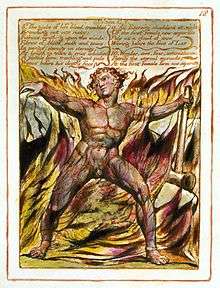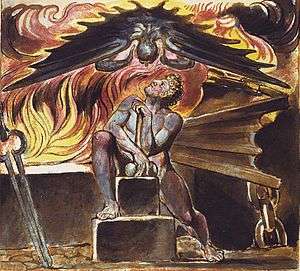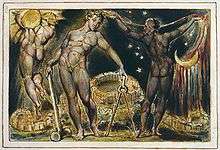Los (Blake)

In the mythological writings of William Blake, Los is the fallen (earthly or human) form of Urthona, one of the four Zoas. He is referred to as the "eternal prophet" and creates the visionary city of Golgonooza. Los is regularly described as a smith, beating with his hammer on a forge, which is metaphorically connected to the beating of the human heart. The bellows of his forge are the human lungs. Los's emanation, Enitharmon, represents spiritual beauty and embodies pity, but at the same time creates the spatial aspect of the fallen world, weaving bodies for men and creating sexual strife through her insistence upon chastity.[2] In the Book of Urizen (1794), Los and Enitharmon have the child, Orc, who is the embodiment of the spirit of revolution. It is of interest to note that the name 'Los' is, by common critical acceptance, an anagram of 'Sol', the Latin word for 'sun'. Such innovations are common in many of Blake's prophetic poems.
Background
Blake attributed the origin of Los and many of his prophetic works to his home in Lambeth:[3] "Los descended to me... trembling I stood... in the Vale of Lambeth; but he kissed me and wished me health".[4]
Character

Los is the divine aspect of the imagination. After he becomes more mechanical and regular in his actions, he falls and becomes part of the material world. In the fallen state, he becomes the creator of life and of organic systems. He also creates reproduction and the sexes, with his own partner Enitharmon soon after being created. He then creates consciousness through evolution, which leads to the creation of humans. Los is particularly focused on humans and he uses them to breed art and use their imaginations. Eventually, it is through the evolutions of the world that Orc is formed. Like Orc and Orc's cycles, Los is part of cycles as he tries to create the Golgonooza at the beginning of time and the image appears constantly in art. Los's imagination is also connected to the natural cycle, and art within the individual is developed through natural cycles. Art is mimetic of nature but order within nature. Los represents the progression through life to the conscious state.[7]
Appearances

Los appears in The Book of Urizen (1794) as an eternal prophet that binds Urizen after Urizen, the creator of the world suffers from a spiritual fall.[8] He appears in the connected works The Song of Los, America a Prophecy and Europe a Prophecy at the same time. In these works, he begins as a prophet in Africa that describes how Urizen gave laws to the people that bound the minds of mankind. This was accomplished through Los's children with Enitharmon: "Thus the terrible race of Los & Enitharmon gave / Laws & Religions to the sons of Har binding them more / And more to Earth: closing and restraining" (lines 44–46).[9]
The Book of Los, completed at the same time, continues from the story of The Book of Urizen and describes how Los fell and was bound in a human form. It also describes how Los, in turn, bound Urizen in a human form.[10] In The Book of Urizen, Los is constantly at struggle with Urizen to control the world and the two represent opposites. However, this was to later change when Blake added two other beings in his later work.[11] In the early works, however, the binary system is possibly similar to the imaginative and reason sides that Blake divided his own mind and a struggle between the two. He also felt that Los was closely connected to Christ, and that is why Los dominated within his myth.[12]

In Jerusalem (1804–1820), it is said that Los was the progenitor of Adam, Noah, Abraham, Moses, and the other Biblical spiritual leaders.[15] The work also describes the Four Zoas that are four parts that were united in Eternity but exist in a state similar to a giant after their fall. These four parts include Los and Urizen along with Tharmas and Luvah. The Four Zoas appear also in 2nd edition of Vala, or the Four Zoas (1807) and Milton: a Poem.[16] In Milton: a Poem (1804–1810), Los is appears as a flaming sun.[17] This view of Los and the sun is similar to a description in a poem that Blake included in a letter (22 November 1802) that he wrote to Thomas Butts, and he believed that in the vision he was able to unite with Los.[18] In Vala, or the Four Zoas, Los witnesses a vision of the Lamb of God being sacrificed to reveal his spiritual side while Urizen and the Synagogue of Satan work against Christ and are the ones who condemn him to death. After the Synagogue of Satan promotes Deism, Los seizes the sun and the moon and breaks apart the heavens. The destruction of the world leads to eternity and the second judgment unfolds. The poem ends with Urthona, Los's unfallen state rising up and shepherding in science and removing the dark religions.[19]
The final version of Jerusalem, completed by 1820, was a Gospel about the imagination as God's presence within humanity, and the messiah figure of the work is Los. Los's purpose was to create his own system in order to be free of any other system, and this system would be based on creation instead of reason. The purpose of the work is to describe Los's triumph and the new apocalypse in which the Lamb of God comes to England to rule.[20]
Notes
| Wikimedia Commons has media related to Los (Blake). |
- ↑ Morris Eaves, Robert N. Essick, and Joseph Viscomi (eds.). "The Book of Urizen, copy G, object 18 (Bentley 18, Erdman 18, Keynes 18)". William Blake Archive. Retrieved October 7, 2013.
- ↑ Damon 1988 pp. 124–125
- ↑ Bentley 2003 pp. 124–125
- ↑ Bentley 2003 qtd p. 125
- ↑ "Copy Information for Jerusalem The Emanation of The Giant Albion". William Blake Archive. Retrieved Sep 11, 2013.
- ↑ Morris Eaves; Robert N. Essick; Joseph Viscomi (eds.). "Object description for"Jerusalem The Emanation of The Giant Albion, copy E, object 15 (Bentley 15, Erdman 15, Keynes 15)"". William Blake Archive. Retrieved September 12, 2013.
- ↑ Frye 1990 pp. 254–258
- ↑ Bentley 2003 pp. 152–153
- ↑ Bentley 2003 pp. 154–155
- ↑ Bentley 2003 pp. 156–157
- ↑ Bentley 2003 pp. 198–199
- ↑ Bentley 2003 pp. 271–272
- ↑ Morris Eaves, Robert N. Essick, and Joseph Viscomi (eds.). "Notes on:A Large Book of Designs, copy A, object 2 (Bentley 85.2, Butlin 262.3)". William Blake Archive. Retrieved January 13, 2014.
- ↑ Morris Eaves, Robert N. Essick, and Joseph Viscomi (eds.). "A Large Book of Designs, copy A, object 2 (Bentley 85.2, Butlin 262.3)". William Blake Archive. Retrieved January 13, 2014.
- ↑ Bentley 2003 p. 11
- ↑ Bentley 2003 p. 199
- ↑ Bentley 2003 p. 217
- ↑ Bentley 2003 p. 269
- ↑ Bentley 2003 pp. 310–311
- ↑ Bentley 2003 pp. 314–315
References
- Bentley, G. E. (Jr). The Stranger From Paradise. New Haven: Yale University Press, 2003.
- Damon, S. Foster. A Blake Dictionary. Hanover: University Press of New England, 1988.
- Frye, Northrop. Fearful Symmetry. Princeton: Princeton University Press, 1990.
- Mee, Jon. Dangerous Enthusiasm. Oxford: Clarendon, 2002.